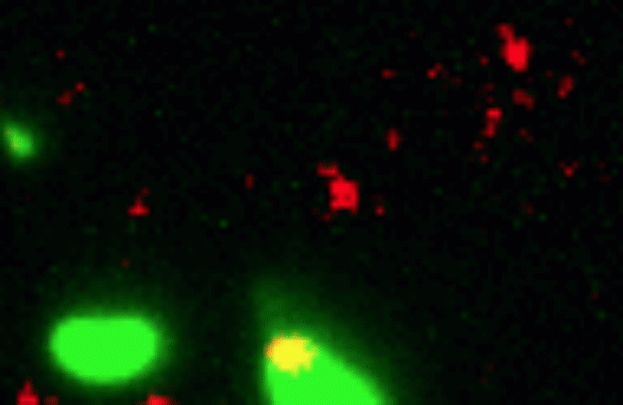A Bacterium Reaches Out and Grabs Some New DNA
Posted on by Dr. Francis Collins

Credit: Dalia Lab, Indiana University, Bloomington
If you like comic book heroes, you’ll love this action-packed video of a microbe with a superpower reminiscent of a miniature Spiderman. Here, for the first time ever, scientists have captured in real-time—and in very cool detail—the important mechanism of horizontal gene transfer in bacteria.
Specifically, you see Vibrio cholerae, the water-dwelling bacterium that causes cholera, stretching out a hair-like appendage called a pilus (green) to snag a free snippet of DNA (red). After grabbing the DNA, V. cholerae swiftly retracts the pilus, threading the DNA fragment through a pore on the cell surface for stitching into its genome.
Why do bacteria do this? In order to survive and thrive in a variety of environments, organisms continually need to add variation to their genomes that enables them to evolve new adaptive capabilities. Humans and many other organisms do this through sexual reproduction. But because bacteria reproduce asexually by cell division, they need something else to add genomic variation. One way bacteria do this is by horizontal gene transfer, a process in which they lay claim to loose scraps of DNA, often the remnants of other dead bacteria, and incorporate this new genetic material into their own.
That’s good news for bacteria. But, unfortunately for us humans, horizontal gene transfer also enables harmful bacteria to develop resistance to antibiotic drugs. Now that we can visualize exactly how horizontal gene transfer works, it may be possible to develop new and better strategies for interfering with this process.
This time-lapse montage, highlighted in a recent paper in Nature Microbiology, was produced through a collaboration between researchers at Indiana University, Bloomington and Brooklyn College, NY [1]. To visualize the tiny, ultra-thin pilus, the team, led by Courtney Ellison, Yves Brun, and Ankur Dalia, developed a groundbreaking approach that swaps out one of the normal amino acids in the pilus fiber for the amino acid cysteine. It allows these structures to be tagged with fluorescent chemical dyes that bind to cysteine [2]. With that substitution, the pilus becomes brilliantly visible. This is yet another example of the many biological marvels made possible by NIH-supported research!
References:
[1] Retraction of DNA-bound type IV competence pili initiates DNA uptake during natural transformation in Vibrio cholerae. Ellison CK, Dalia TN, Vidal Ceballos A, Wang JC, Biais N, Brun YV, Dalia AB. Nat Microbiol. 2018 Jun 11. [Epub ahead of print]
[2] Obstruction of pilus retraction stimulates bacterial surface sensing. Ellison CK, Kan J, Dillard RS, Kysela DT, Ducret A, Berne C, Hampton CM, Ke Z, Wright ER, Biais N, Dalia AB1, Brun YV. Science. 2017 Oct 27;358(6362):535-538.
Links:
Cholera (National Center for Advancing Translational Sciences/NIH)
Brun Lab (Indiana University, Bloomington)
Ankur Dalia (Indiana University)
NIH Support: National Institute of General Medical Sciences; National Institute of Allergy and Infectious Diseases

Isn’t this what Dr. Virginia Livingston Wheeler in California claimed in the ’90’s, and prepared accordingly autologous vaccines from these pleomorphic microorganisms to treat her cancer patients?
Not sure how feasible, but it will be nice to let the DNA change color once it is grabbed, so we can clearly see where it is ending. So far from the time-lapse montage, it looks like that snip of DNA was lost in the mid-way. Is this technique restricted to 2D view?
“Need to” implies purposeful motives for the action. This is not part of classical evolutionary theory. Maybe by design the organism has the ability to incorporate foreign genetic material but would do so randomly, not aware of the “need” for such action. This seems more like engulfing as in an amoeba.